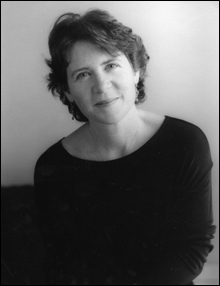 HOME BODY:
Berne’s story sets up the narrative tension of a “whodunit” but goes for deeper psychological depths.
HOME BODY:
Berne’s story sets up the narrative tension of a “whodunit” but goes for deeper psychological depths.
|
In her third novel, Newton writer Suzanne Berne plumbs the rich possibilities of a few juicy literary
ingredients: a snowy Thanksgiving weekend, a creaky old Concord colonial, and two semi-estranged sisters with opposing versions of childhood events — including the details of their mother’s death. The Ghost at the Table stirs this all up, adds a fine cast of supporting characters, and throws in the twist of an increasingly unreliable narrator.
Cynthia is the sister who lives as far from Concord as possible — in San Francisco, where she writes historical fiction about famous women from the point of view of a lesser (but devoted) sister. “Going home for Thanksgiving,” she begins The Ghost at the Table, “wasn’t something I had planned on — or I should say, I hadn’t planned on going to Frances’s house in Concord, which over the years I’ve sometimes referred to as ‘home,’ simply because it’s back east. But perhaps Frances heard me differently when I said ‘home,’ perhaps she heard more than I meant to suggest.” That opening, with all its qualifications and prevarications, forms the axis on which the book turns. The way we see things, the way others see things, and the struggle to make our version of events the accepted family lore can be bitterly fierce.
Frances coaxes Cynthia into coming east with high hopes for a “perfect” holiday, à la Martha Stewart. A cultivator and curator, she’s furnished the antique home she shares with her husband and daughter with a set decorator’s exacting eye. Ensuring that her sister and their invalid father are at the Thanksgiving table is one more important element added to the design.
As girls, Frances, Cynthia, and their late sister, Helen, watched their mother waste away from a degenerative illness while their father lived life with a kind of vengeful vigor: hiking, spouting Mark Twain maxims, and yes, fooling around a bit. Not long after their mother’s death, he marries the young woman who has been caring for his daughters, and he ships Cynthia and Frances off to boarding school.
What’s more, shadowy questions surround the circumstances of their mother’s death. Yes, she had been sick for a long time, but small details — an empty pill bottle, a funny-smelling broth, a zealously devoted nurse — create the makings of a classic mystery. Readers intent on discovering “whodunit,” however, should look elsewhere. Berne finds more drama in the struggle between Cynthia and Frances, each with her own memories of the past and ideas about how to shape the family story.
Biographical details of a book Cynthia is researching about Mark Twain’s daughters mirror some aspects of the sisters’ lives and offer an alternative jousting ground. Was Mark Twain a loving father or an overbearing monster? “Tell about Twain dressing up as Santa Claus,” Frances urges, but Cynthia would prefer to describe his preference for the little girls he invited to lunch and dressed in harem outfits.
The tension mounts as Thanksgiving approaches. As she showed in A Perfect Arrangement, Berne has a talent for wreaking havoc in the midst of utter domesticity. Cynthia’s voice holds the book together, offering moments of humor and clarity. “Drunk as I was, I understood perfectly well what Frances wanted from me . . . the tale of Mark Twain’s daughters and their pleasantly eventful childhood. She wanted what everyone wants — what even I wanted — a good story with a reasonable ending.” Family stories usually don’t offer that sort of tidy closure, Berne makes clear; they just hold a mirror up to our own desires and fears.